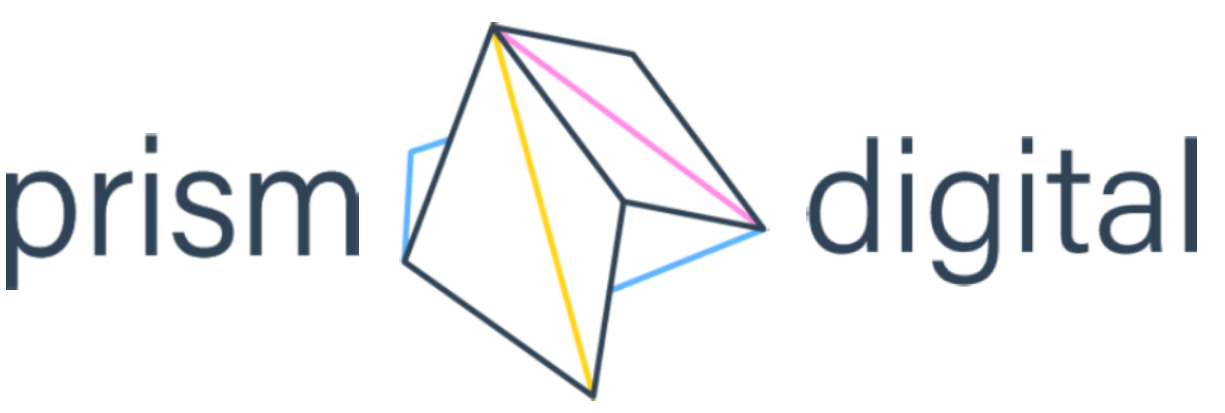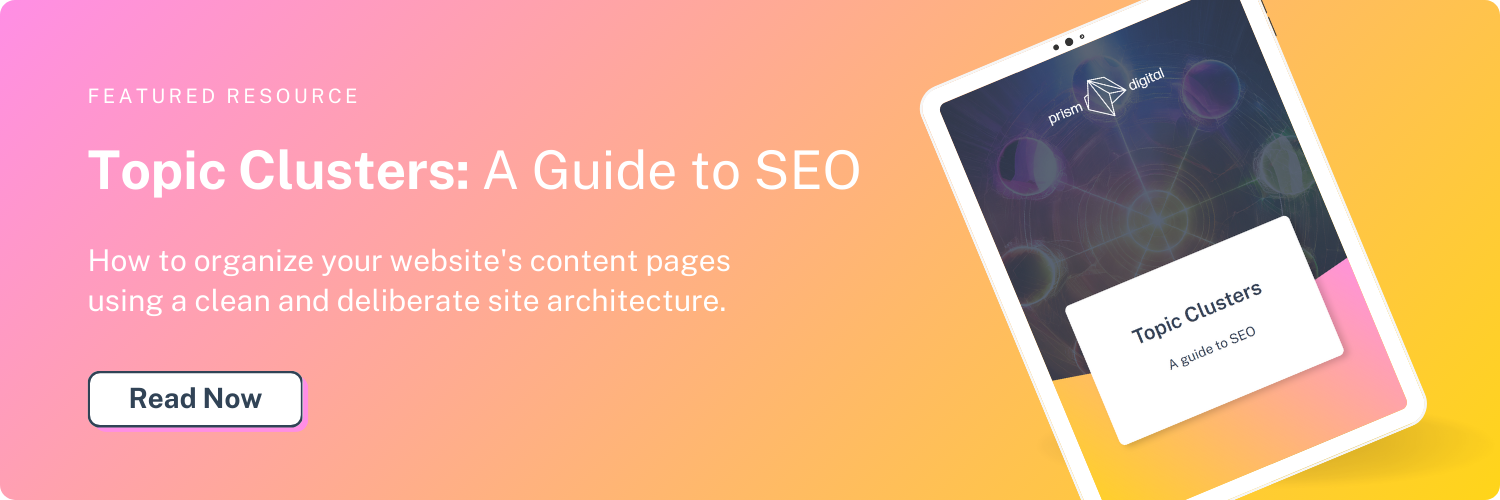Creating a Content Strategy:
The Ultimate Guide
What is content marketing strategy?
As traditional marketing becomes less and less effective, business owners are looking for better ways to grow, engage and retain their audience.
Enter content marketing.
“Content marketing is a strategic marketing approach focused on creating and distributing valuable, relevant, and consistent content to attract and retain a clearly defined audience — and, ultimately, to drive profitable customer action.” (Content Marketing Institute)
A well-executed content marketing strategy is a superb way to promote your brand. And, ideally, make your business stand out when it’s time for consumers to make a purchase.
What is the purpose of a content strategy?
Rather than haphazardly churning out content and hoping it does the job, wouldn’t it make sense to document your efforts?
An effective content marketing strategy will help you achieve specific goals, define clear success metrics, and create processes for precise improvement. In fact, 78% of brands that were successful with content in 2022 had a documented content strategy.
The chief benefits of a content strategy include:
- Nurturing an audience—Top content marketing methods warm up your audience to the thought of purchasing your products or services.
- Online visibility—The more consistently you post educational, useful content that addresses your audience’s pain points, the more customers you can attract.
- More leads—Content is the foundation of your lead generation and lead nurturing efforts: because a good content marketing strategy drives traffic, it can also drive leads and increase revenue.
- More authority—The more useful content you share over time, the more people in your niche will see you as an authority figure. By continuously demonstrating your expertise in a particular field, you may be able to achieve thought leadership, using your business experience and passion to consistently answer the questions of your target audience.
- More budget—Making your case for a larger marketing budget? If you can prove your previous marketing success, you can articulate the value of your content and reposition it as a crucial business asset.
- Google ranks content according to E-A-T—Expertise, Authority, and Trust are three factors that Google uses to measure how much trust it should place in your brand or website. Google wants to give its search engine users the best experience possible, so it only wants to promote websites with quality content.
Content marketing examples
When it comes to writing “good content” you should be aiming for originality and actionability, providing the answers to questions potential customers might ask. Some common content marketing examples include:
Blog Posts
Blogging is an integral part of any content marketing strategy because it is the part of your website that you will most frequently update with new posts and information to keep readers engaged. It is often through blog content that you first entice people to your site and start to build your brand's audience.
Emails
Think of a well-executed email strategy as the backbone of your content marketing strategy. Effective emailing will support your various content efforts and is the best technique for building a subscriber base – which is critical for achieving value from your content marketing strategy.
Newsletters
A regular email newsletter is one of the best ways to consistently get your content in front of the right people. After all, email acts as a direct line to your audience and makes it easy to update them about any valuable content you have created.
Social media posts
Social media is a helpful tool to develop a brand voice or personality. By pushing compelling content to different platforms you can increase brand awareness and differentiate business from its competitors.
Podcasts
Offering regular long form content keeps people connecting with your brand and increases community engagement.
Ebooks
People download eBooks because they have a need to access the information presented in them. By offering your eBook for free, you give readers a high perception of content value. Then, after you establish credibility and potential problem-resolution, you can subtly guide the reader toward your business and its solutions.
Videos
Video content is a useful tool when it comes to explaining your product and helping potential buyers learn about your particular niche.
The essential elements of a powerful content marketing strategy
An effective content marketing strategy should have these 5 core elements in order to be successful:
- A defined target audience
- Explicit and measurable goals
- A diverse range of content
- A clear brand story
- A robust distribution and promotion strategy
A defined target audience
Successful content marketing is all about creating content that’s useful to your audience, as opposed to highly promotional sales messages. But for you to be able to create content that appeases your audience, first you need to know who your audience is. Unless you have a clear idea of who you’re creating content for, you will have no idea what is useful for them—go figure!
Here are a few ways to do that:
- Survey the customers you already have
- Research current industry trends
- Identify who you don’t want to target
- Pay attention to who your competitors target
Once you have your audience in mind, you can develop some buyer personas to help you clearly and succinctly communicate your audience to your stakeholders. And anyone involved in brand messaging.
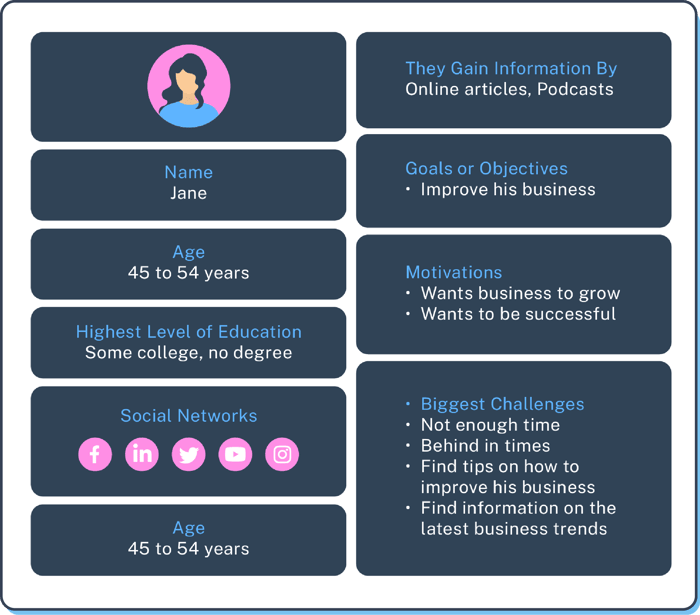
Explicit and measurable goals
What does success look like to you? If you want to know how successful your marketing campaigns are, you’ll need to set clear goals that you can measure your performance against.
Your goal may be to raise brand awareness, build brand credibility, generate leads, or something else. When you understand the most common content marketing goals, it can give you a better idea of what you can achieve.
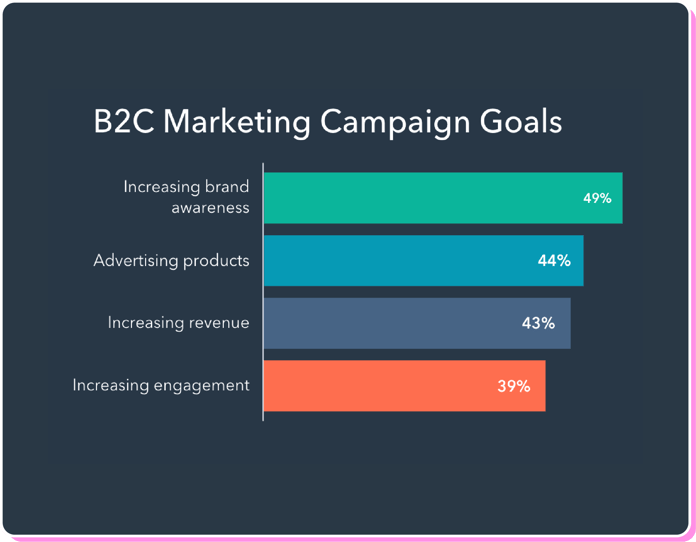
Top tip: Make sure whatever goal you set is highly specific with a defined timeline. For instance, there’s no use just vaguely aiming to generate more leads, because there’s no way to really understand the impact of your campaign. Instead, you should aim for a specific number of leads within a specific time period. So in this case, maybe your goal is to generate 2X more leads within the next three months.
A diverse range of content
The type of content you can use for your campaigns doesn’t start and end at blog posts. After all, not everyone may be interested in reading your blog posts; some may prefer visual content and others may like audio content.
In order to intrigue different types of personas, it’s a good idea to diversify your range of content. From product demo videos, infographics, ebooks and webinars, to podcasts, case studies and interviews with industry influencers - a broad range can increase audience reach and improve brand recognition.
You should also consider the effectiveness of specific types of content based on the lifecycle stage of your customers:
- Blog posts, articles, ebooks, podcasts, and videos are the most useful at the awareness stage.
- Whitepapers, webinars, case studies, and interactive content are ideal for the middle stages.
- And case studies and in-person events are best for the final stage of the buyer’s journey.
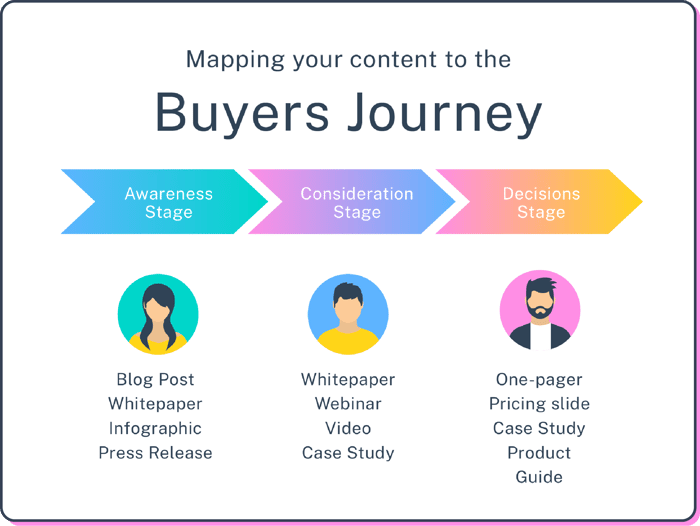
A clear brand story
A brand story is a summary of your company’s history, mission, purpose, and values. By defining your brand story, you can identify the right messages and topics to address within your content—helping you choose the right direction to go with your strategy.
Your brand story should focus on:
- Your customer, their goals and challenges
- Your brand’s personality
- The purpose of your brand and key brand values (what makes you different from your competitors?)
- The way your product can help solve your customer’s problems
Keeping your brand’s story in mind when making content will create a consistent experience for your audience and drive home your key values across all of your content marketing channels. In fact, a comprehensive study by Lucidpress shows companies that present their brand consistently across every touchpoint enjoy a 33% increase in revenue.
A robust distribution and promotion strategy
Content marketing doesn’t just end when the content has been developed; distribution and promotion are equally crucial aspects of your strategy. At the end of the day, you want to make certain your content reaches as many people as possible so it can drive brand awareness and engagement, and possibly even conversions. This means you should plan an effective strategy for distributing and promoting your content, picking the best channels to convey your message. Consider the following:
- If you’re using social media, which platforms would be best for you? Ideally, this will mean choosing the social media platforms where your audience is the most active. You could test out different distribution channels to see which ones work best, and then realign your efforts with a focus on those platforms.
- Have you thought about distributing your content through content syndication platforms? Paid promotions on social media may also prove highly effective, especially when you’re just starting out.
- What about working with a relevant industry influencer to promote your content? This would allow you to tap into an established and relevant audience - for a price, of course!
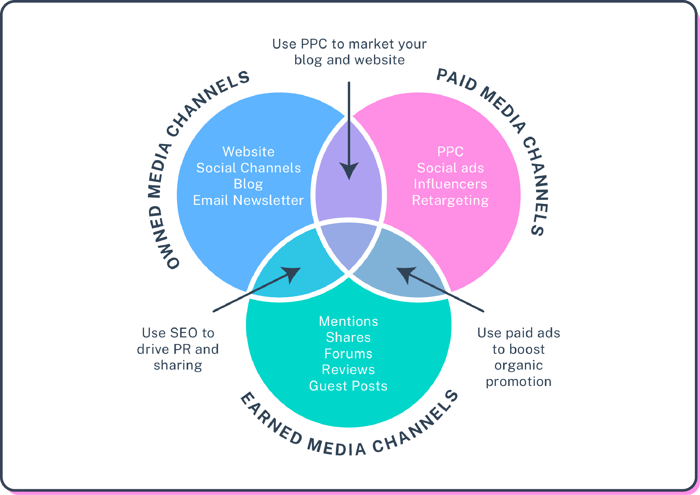
10 steps to create a complete content strategy
It’s time to meet those business goals! Follow these eight steps to develop and implement your own kick-ass content marketing strategy.
Step 1: Identify your audience
From your existing audience, it’s possible to figure out who your target audience is by looking at your analytics tool and going through each platform one by one. This process alone will give you some valuable information about which platforms your audience use, and how they use them.
UTM (Urchin Tracking Module) codes can be used to learn more about who engages with your social posts. These are simply a piece of code that gets added to a post which means you can find out where your audience is coming from and some information about them. They tie in with Google Analytics and allow you to see the demographics of who is engaging with you on social media.
“How does my audience differ from my buyer personas?”
Buyer personas will form the base of your content strategy, but keep in mind that your audience isn't only made up of buyers. Your audience will also include people who begin interacting with your brand long before they make a purchase. So it’s essential to distribute content that will attract potential customers before they begin the buyer journey:
- First, draw people into the world of your brand with helpful content that educates or entertains.
- Next, follow up with content that illuminates how you help when they’re ready to take action.
- Remember, by becoming a valuable source of information you can forge a community of brand advocates. These are the people that will share your content and help boost your brand awareness.
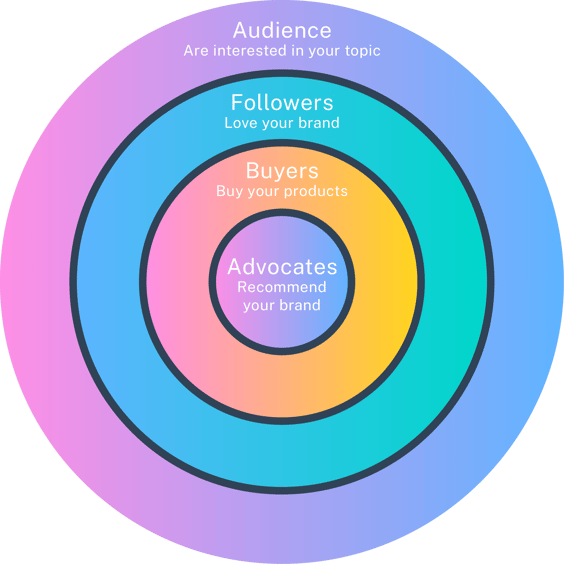
Step 2: Map out your key marketing goals
Setting measurable digital marketing goals should always be made a priority, as they will be the basis of your entire strategy. After all, how do you know what you're working towards without clear, actionable, and achievable metrics?
Setting marketing objectives is, on one hand, a great way to motivate yourself and your team and work towards achieving better results for your business. On the other hand, objectives and KPI-setting is about much more than just saying “I want to achieve that and that”— it comes down to how well you can develop a plan or strategy that will help support your vision and reach your key marketing goal. Whether that’s raising brand awareness, attracting traffic or generating more leads.
An example of a measurable goal could be:
“In 2023, we want to achieve a 10% increase in revenue created by organic content and generate 5,000 qualified leads with a budget of $10,000.”
How to set SMART goals
When it comes to setting content marketing goals, there are various criteria you can use. We recommend strategic marketing planning through SMART goals, which cover every important aspect of a successful marketing goal:
Specific: Your goals should have a very clear objective.
Measurable: KPIs will help you understand whether you’ve reached your goals or not, so you can evaluate whether or not your efforts have paid off and how they have translated to revenue.
Achievable: When setting goals, it’s a great idea to aim high – but not so high that they're unrealistic!
Relevant: How do your digital marketing goals help you reach your business goals? At the end of the day, the whole point of developing all of these marketing strategies is to help grow your business.
Time-bound: Giving your goals a clear deadline tells you when you need to measure your results and benchmark these results against past (and future) campaigns. This is another highly important practice as it helps you understand how to optimize your future strategies in order to achieve better results.
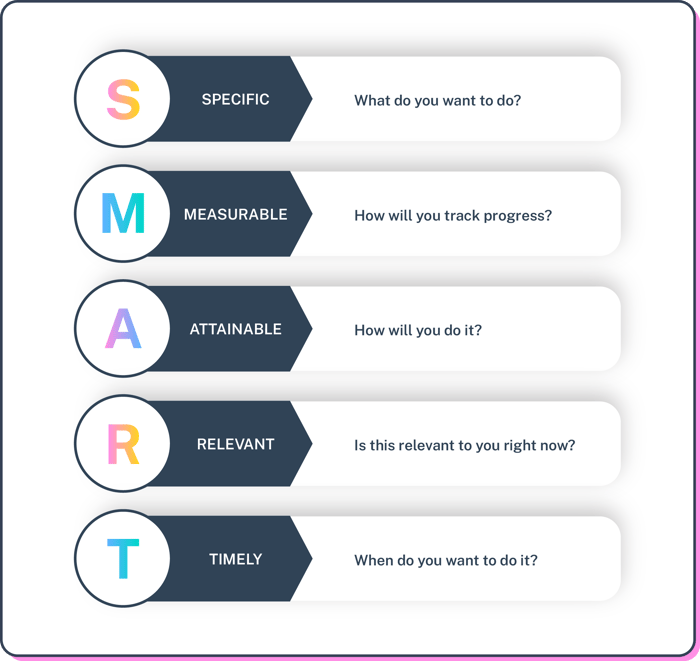
Step 3: Audit the content you already have
65% of successful brands run content audits more than twice a year… but why?
Content auditing describes the process of collecting and analyzing all of the assets on your website, such as landing pages or blog posts. Content audits keep an inventory of what you’ve got and provide insight into which content to create, update, re-write, or delete. A thorough content audit will allow you to make the most out of your existing pages—which means you could save resources on creating new content, boost engagement, generate more organic traffic and rank higher in search engines.
Benefits of Content Audits
- Better understand what kinds of content formats and topics resonate with your audience
- Asses whether or not readers find your website easy to navigate and free of error
- Get data-driven insights into the performance of your content, so you can make informed decisions about where to go next
- Where numbers are low, identify content that can be repurposed or updated
- Highlight pieces of content that perform best
- Gain a deeper understanding of what your audience likes and dislikes
Top tip: Don’t rush the auditing process. In order for it to be valuable, it needs to be done right. Don’t worry though, you don't have to be in it alone! There are plenty of online templates to guide you through a content audit if you're unsure of where to start.
Step 4: Develop a content calendar
All businesses can benefit from a planning document that gives an overview of what's in the publication pipeline, and that’s exactly what a content calendar does. The main purpose of a content calendar is to help plan, manage, and coordinate the various stages involved in content creation – idea generation, production, publishing, and promotion. Digital marketers use content calendars to plan digital content by date, manage campaigns, and review ongoing marketing strategies.
Generally, a content calendar will include the date and time your content will go live, the place it will be published, copy and creative assets required (i.e., photos or videos), and links and tags to include.
Step 5: Find relevant topics
One of the most time-consuming parts of content marketing is finding new content topic ideas to target in your blogs, discuss in your videos or post on your social media channels. When beginning the process of choosing relevant content topics, always consider the big picture. For example, what overarching themes do you want to cover this year? Try generating a list of themes that are likely to stay relevant long-term, be useful to your target audience and impact the bottom line.
We find one of the best and simplest tools to come up with content topic ideas is using Google. Sometimes this is all you need to find new topics for your content marketing.
How to use Google search suggestions
Go to Google.com and start typing your main topic keywords. As you type, you’ll notice that Google makes recommendations. Finish writing your main topic idea, for example, “Content marketing”—you could use these suggestions, or start typing letters, starting from letter ‘a’. What this will give you is a combination of topics that include your main search terms and other popular keywords.
How to use Google “People Also Ask”
For most topics, people use Google to ask questions, therefore Google wants to rank websites that can provide the answers. The best way to use this feature is to try a combination of related searches and spot common topics in the “People also ask” section.
For example, if you search for ‘content marketing’ related terms, you’ll notice that in the questions, people ask ‘strategy’ related questions like “How to create a good content marketing strategy”, “What is a good content strategy” and many others. This is a pretty big hint that ‘content marketing strategy’ is a good topic to cover!
How to use Google “Related Searches”
The related searches section, which is located at the bottom of the search page, shows you a list of topics that are related to your search.
For example, for “content marketing” a related topic is “small businesses” - so if you’re already writing about content marketing, you can further expand your content by providing more content aimed at small businesses.
Other free ways to source new content ideas include:
- Google Trends
- Topic Research Tool (SEMRush)
- Answer the Public
- Competitor Websites
- YouTube Search
- Google Analytics
- Google Search Console
- UberSuggest
Top tip: It’s also important to find out what your competitors are doing. Find the topics, keywords, and content formats that work well for them and try to replicate that success. Look carefully at:
- Their tone of voice and target audience
- The main content formats they use (e.g., blogs, podcasts, video)
- The main content categories they cover
- Primary keywords they target (try using the Semrush keyword Gap tool)
Step 6: Build topic clusters
A topic cluster is a group of pieces of content that all fall under the same overarching theme. These pages offer comprehensive coverage of a specific subject and all link back to the same pillar page. The topic cluster model enables visitors to satisfy their search query while visiting one of the main pages of your site.
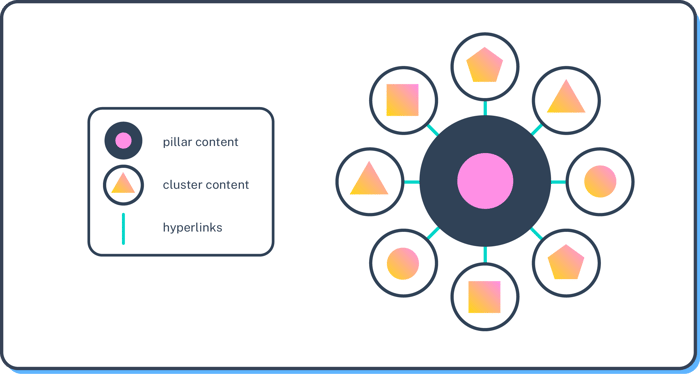
This organized approach is especially helpful if you have lots of content and want to build authority on a certain topic. Building topic clusters in one of the most effective ways to organize your content and is thought of as an SEO best practice.
Step 7: Design your content funnel
Your business can use a content marketing funnel to visualize how you will successfully use content to attract potential clients and guide them through their journey: from the first interaction, to conversion and into a paying customer.
Before you even think about content creation, make sure you’ve thought about the purpose of each piece of content you plan to produce. You should have a piece of content for every part of the customer journey. This is important because your audience will differ significantly in each stage.
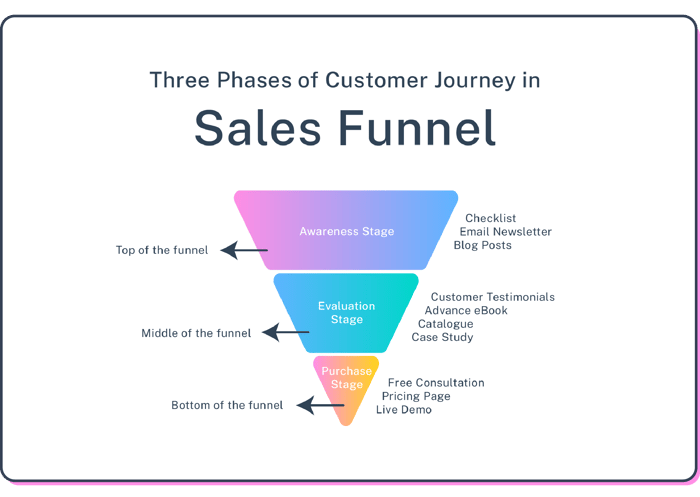
- Though the vast majority (87%) of marketers create content for different customer journey stages, the top of the funnel remains the most popular one – 95% of marketers create TOFU content.
- Then comes the middle of the funnel (MOFU), covered by 86%.
- Finally, 76% of marketers create bottom-of-the-funnel (BOFU) content.
These figures prove the idea that marketers support their audiences with content throughout the entire customer journey. Content is expected to attract the attention of potential customers, explain the product service value, and close the sale afterward.
Step 8: Create your content
At last, it’s time to create valuable, quality content that helps you rank!
Use these simple strategies to resonate with your audience:
Be original
When people read your content, they want to know that what they’re reading has been accurately written by a real person with some experience on the topic. Original content not only helps you establish your website as an authority in your industry, but it also has a significant impact on your overall rankings in search engines.
At this point in time, it’s pretty much a given that someone else on the internet will have published content on the topic you want to cover. But don’t let that put you off! You can always take it one step further by including your unique experiences, data, research, and opinion.
This will help build credibility and trust with your audience, creating a foundation for your organic growth.
Diversify your content
Variety is the spice of life, sure, but don’t forget to create content with your audience in mind. Your selection should depend on your customers’ preferences and your analysis of content performance: some content types may work better at specific stages of the funnel, whilst others work better for a specific audience.
Ideally, you’ll be able to include a diverse mix of content formats, but you don’t need to produce every type of content possible. This graphic breaks down a few options you might want to include in your content strategy:
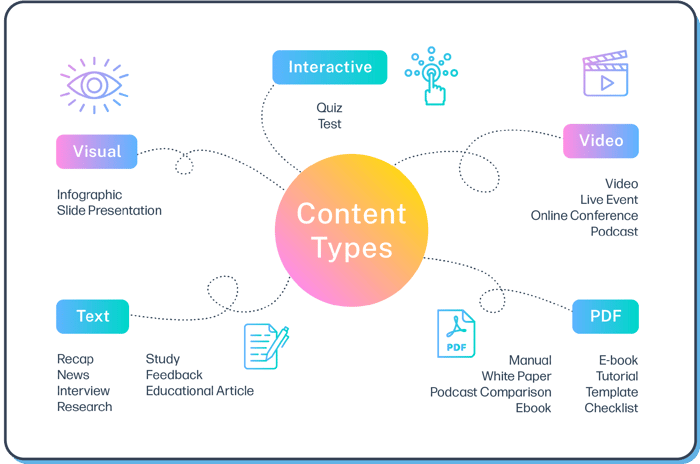
Repurpose, repurpose, repurpose!
The primary benefit of repurposing content is that it makes content SO MUCH easier to scale. In other words: there’s no need to write every post, shoot every video and design every infographic from scratch. Instead, you can use a piece of new content as the basis for posts, videos, social media posts, webinars and more.
Take advantage of user-generated content
User-generated content (UGC) is any content—text, videos, images, reviews, etc.—created by people, rather than a business. It’s original, brand-specific content created by customers and published on social media or other channels. UGC comes in many forms, including images, videos, reviews, a testimonial, or even a podcast.
So, why is UGC so effective? It all comes down to authenticity… With fierce competition for audience attention, brands have to fight to be seen online and buyers are more selective about the brands they interact with and purchase from. Ultimately, there’s no other content type that’s more authentic than UGC from your customers, brand loyalists, or employees. And with consumers 2.4 times more likely to view user-generated content as authentic compared to content created by brands, the time to invest in an authenticity-driven social marketing strategy is now.
Step 9: Plan your content distribution
Content distribution works best when various paid, organic, and earned channels are used to publish and promote your content. The three types of content distribution channels can be broken down as follows:
|
Owned media channels |
Blogs, landing pages, social media profiles, newsletters |
Leverage other channels to drive traffic to your owned media channels and grow your audience. |
|
Paid media channels |
Social media adverts, pay per click advertising, sponsored content, influencer campaigns |
Use paid channels to promote your most essential content—such as landing pages and lead generation content. |
|
Earned media channels |
Shares, mentions, testimonials and reviews, guest posts |
Put some effort into posting exciting, sharable content that is true to your brand story. |
When planning your distribution methods, be sure to list the core channels you will target, analyze their historical performance, and develop ideas on what you can improve.
You know what your customers like (or at least you should), so use this knowledge to determine which channels should be in your mix. Based on recent research, the most popular content distribution channels in 2021 included social media (organic and paid), email marketing, and organic search.
Top tip: Ensure the bulk of your resources go to channels you know your audience prefers, in order to give your content the best chance of being seen. But don’t shy away completely from exploring new channels, for example using influencer marketing opportunities and partnerships.
Step 10: Analyze your content performance
We can’t stress enough how vital it is to monitor and analyze the performance of your content on a regular basis. This data will not only help you to identify poor-performing content that can be improved, but also to find your best-performing content so you can find the perfect “recipe” for your content marketing success.
Five important metrics to measure your content performance are:
Traffic
Traffic is the lifeblood of online content. Afterall, there’s really no point in creating amazing blog posts if nobody is going to see them. In Google Analytics, the metrics you want to be looking at are:
- Users—he total number of unique visitors to your page
- Pageviews—the total number of times a page on your site has been viewed
- Unique pageviews—If a single user has viewed your page multiple times, these visits are combined into one pageview to calculate this metric.
Sales or conversions
Great—people are visiting your site and reading your blog but what else are they doing when they’ve finished reading? Are they clicking your links and reading more? Are they signing up for your newsletter? Completing an e-commerce transaction?
It’s up to you what counts as a conversion. In some cases, the goal of your content might be to make a physical sale, while in others it just might be to raise awareness of your brand and increase your authority. If this is the case you might want to focus more on metrics such as social shares and engagement.
However, if your blog is primarily a sales tool, you’re going to want to track how many sales it generates. You can do this after activating e-commerce in Google Analytics by viewing the page value of all your content under the behavior section. This will give you the average revenue that each page has generated for you when users have gone directly to make a purchase or complete another goal that you’ve set.
Engagement
To find out if people are engaging with your content, you’ll need to track how long they’re spending on your site and how many pages they’re visiting in each session. The aim of the game is to keep readers on your site as long as possible so they can read more of your content (unless of course, you want to funnel them to a sales page as quickly as possible.) You can see this information under Audience Overview in Google Analytics. Here, as well as seeing your total number of sessions and visitors, you can see the average number of pages per session, the average session duration, and your bounce rate.
For content that’s designed to be read, ideally, you want:
- high number of pages per session
- long average session duration (depending on the length of your content)
- low bounce rate
Social media engagement
While there are various metrics you can track here, the most important is how many times your content has been shared on various social networks. A share shows that other people are finding your content valuable in some way. Unfortunately, this information isn’t available in Google Analytics but if you have social share buttons on each piece of content, they will show you how many times that content has been shared on each platform.
Buzzsumo is a great tool for tracking social media shares and is an easy way to quickly identify the top performing content on your site.
SEO performance
There are a few different metrics you can track in order to gauge your SEO performance. SERP ranking is probably the most important one and will tell you the position of your content in the search engine results pages for a particular keyword phrase. Rankings aren’t static and do tend to fluctuate a little, but when you’re tracking your ranking over time you want to see it either static (if you’re already in a good spot) or improving, which shows you are gaining trust and authority.
You can use Google Search Console to identify the terms you’re ranking for and keep an eye on how your ranking changes over time. Better SEO will lead to higher traffic numbers, more leads, and hopefully more sales and conversions.
Partner With a Marketing Agency
Content marketing can feel overwhelming, and in order to succeed, you have to be strategic. For some businesses, this means partnering with a digital marketing agency that can develop a top-notch content marketing strategy based on customer personas and reliable data.
Partner with Prism Digital, and we’ll guide you through the ongoing process of translating your business objectives and goals into a plan that uses content as a primary means of achieving those goals. In order to deliver on our end, we will speak directly to your key audience(s) to drive home the essence of your brand, so you can stand out clearly from your competitors.
.png?width=200&height=73&name=Logo(1).png)
